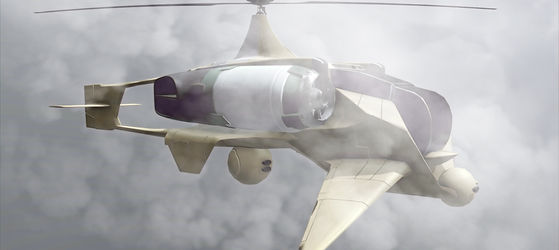
Project Wyvern
The maiden project UASA will adopt 'Wyvern' , aims to develop an affordable, efficient, scale-able sub 25 Kg compound UAV Helicopter design, that has long range, above average UAV payload capability, stable and can keep flying to a safe landing in the event of main power failure. Wyvern is constructed using commercial aviation standard design methodology, not hobby grade UAV methods. Wyvern is designed for civilian and defense reconnaissance use especially in marine/coastal applications. Note specifications subject to change over the development cycle.
Wyvern is optimised for a cruise over 60 km/h with a maximum speed of 150 km/h, 50% faster than a conventional helicopter, it will consume 15% less fuel per distance than a traditional helicopter and aim for a 25% cost reduction per distance due to advanced lift and engine management systems.
The four lateral pusher/pull propellers generate forward thrust, counter torque and are isolated from the main fuselage by the center wings which serve to generate lift at cruise velocity. This allows the main 2m rotor to be slowed by up to 15% as the craft's air speed increases and prevents the rotor blades breaking the sound barrier which would reduce performance. Forward flight is augmented by four electric motors, of which, two are capable of shutting down and restarting once in flight to save fuel and increase range.
It will have a low weight and low maintenance metallic-composite airframe and lower weight high voltage direct current electrical generation. Extended flight endurance, expected to be up to five hours depending on payload, with a MTOW of 25 Kg.

Conceptual compound UAV Helicopter
Wyvern, main power by a four stroke gas (ICE) engine for the rotor and electrical power generator with supplemental lateral electric pusher/pull propeller engines. Designed with four electric motors for lateral thrust, allows for redundancy should one or more motors fail. Forward motion at cruise creates lift from both the center wings and auto-rotation action of the main rotor.
With forward motion maintained, aided by the lateral electric motors and movable flight surfaces on the tail empennage, the aircraft is controllable at all times, as a conventional aircraft in glide mode, should there be a main engine flame out. Forward flight can be maintained for 30 minutes utilising the on-board rechargeable batteries powering the lateral electric motors.
Landing is accomplished using an auto pilot controlled auto-rotation sequence of the main rotor with minimal forward thrust, in the event of main engine flame out. Conventional powered main rotor landings per normal helicopter landing cycle. Note landing gear includes compact wheels also allowing for a rolling stop.


Included in the advanced avionics system is accurate RTK GPS navigation, advanced position hold/navigation (IMU) capability, especially for GPS denied environments and precision landing location sensors capable of landing on a moving platform on a ship.
Utilising advanced composite materials, the avionics are also protected from outside sources of electromagnetic radiation making the aircraft highly resistant to external jamming (CUAV) measures. A choice of avionics are available for military or civilian applications.